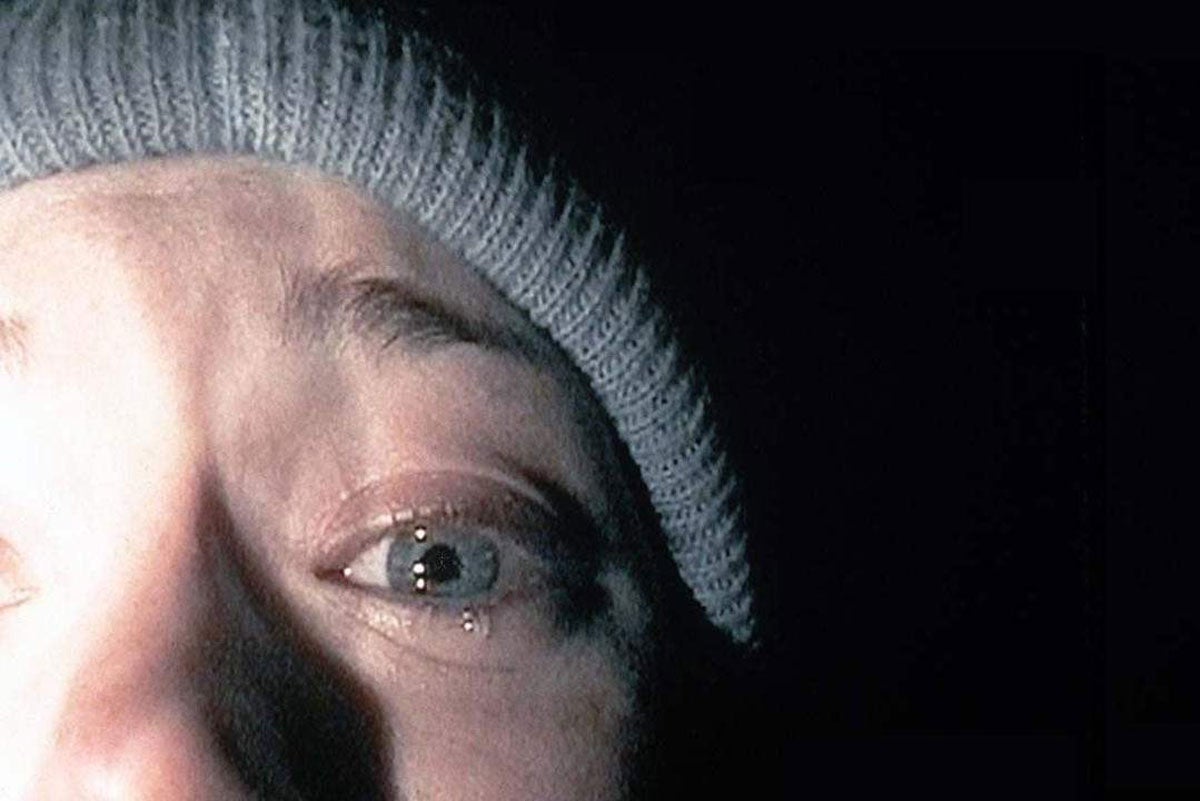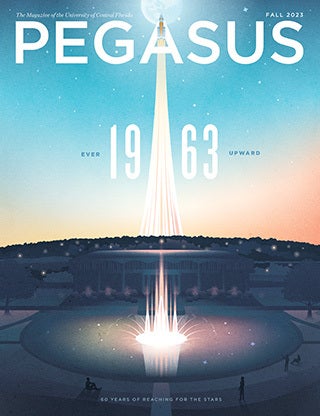Gary Rhodes is an associate professor in UCF’s Nicholson School of Communication and Media and assistant director of the film and mass media program who is best known for his work on horror cinema.
When he was 15, Rhodes says he started writing for a film magazine called Filmfax, and he’s been analyzing movies ever since.
He isn’t entirely sure of the number of horror movies he has seen over the years — probably a few thousand — and he says he needs to invest in a 14th bookcase for his DVD collection (which he stacks two deep to a shelf).
He is an author and/or editor of 20 books on film history and theory, and his most recent book, The Birth of the American Horror Film, was published in 2018.
Rhodes talks through the origin of the genre, a UCF film legacy and what to watch this Halloween.
“Horror” didn’t have its genre coined until 1931, and as a result, Dracula was originally billed as a love story.
No one would have said “horror film” before 1931, even though in retrospect, there were movies that would have classified as horror. Instead, people would use adjectives and speak more specifically about a movie, like: “There’s a new ghost film.” Sometimes they would use the terms “weird” or “fantasy” or “bizarre.” “Uncanny” was a popular adjective at the time. At the turn of the 20th century, “mysterious” was a term that was used a lot. “Trick picture” was often what they were called before 1915 because they were very brief and very reliant on special effects. Almost like a magic show with magic you couldn’t do on a stage.
What happened in 1931 was the film Dracula was released in February of that year. And they didn’t have a clear way to label it, and they were scared as to whether audiences would like it or would be too frightened by it. So, they released it around Valentine’s Day, and they called it “the strangest love story the world has ever known.” It was actually audience members across the nation who chose the term “horror.” Films played over months back then as they made their way from the biggest cities to the smallest towns. As the weeks went on, the critics and the theaters began picking up on the term that the audiences had bestowed upon not only Dracula but then Frankenstein, which was the initial follow-up. It was not a marketing person in Hollywood or a particular movie poster. It was audiences that decided these other terms didn’t fit.
Nearly every horror movie theme was covered by 1915.
In researching my book The Birth of the American Horror Film, I looked at hundreds and hundreds of films made before 1915. I think people today don’t even imagine there were horror films back then. Not only were there hundreds of them, but every single topic you could imagine, from the killer with the knife to the vampire to ghosts to devils to witches to voodoo — every kind of horror we could think of — there are films of those types made before 1915. And yet, the horror film has been unbelievably consistent in its popularity from 1895 which was the year the very first horror film was made.
There once was a theatergoer who was “scared to death.”
Around 1905, there was a little boy who came out of a screening of some of these early horror films and died. And the doctor, according to press accounts at the time, said he had been literally scared to death. I find that story fascinating — how powerful these early films were. It’s impossible for us to think about because cinema has been around for as long as we’ve existed. But the impact of the very first films on the first moviegoers, some of these people had fought in the Civil War — they wouldn’t have seen movies ever before and they certainly hadn’t seen TV. Some people were scared of all films regardless of the image or story because it was overwhelming at the sheer size of the screen. The power the films held then was even greater than a new Halloween film could have over us now.
American horror stories follow two patterns.
As I spent time researching the earliest horror films, I reviewed horror-related poetry, literature, paintings and photographs in America before films were invented. There seems to be an emphasis of two types of horror. One is the Scooby Doo-thing: You see ghosts or you see goblins throughout the film, but then they are unmasked at the end. The supernatural isn’t really happening as it seemed to be.
The other major thread is the supernatural isn’t even at play at all. It’s just Jack-the-Ripper-type murderers, which is what Michael Myers from Halloween is. Freddy Krueger was just another slasher killer but supernatural was added just to make him different from Jason and Michael Myers. There are exceptions, but for every exception, I could list hundreds of films that follow one of these threads.
And yet, despite the repetition, hit films like Get Out find a way to bring new life to the genre.
There have been moments throughout history where all of a sudden, somebody comes up with something quite new. We can mention The Texas Chain Saw Massacre and Halloween in the 1970s as an example where somebody comes up with something so new that it becomes imitated quite a bit. We can say the same thing of The Exorcist. I think what’s interesting is that in recent years, films like Get Out or The Conjuring or Hereditary are attracting more talented and creative writers, directors and famous actors who years ago would have said, “I’m not going to be in a horror movie. Even if I need the money, I won’t do horror.” I think that’s the great thing of the recent films like Get Out. Not only are they introducing something new, but they’re also just simply, extraordinarily well-made films by very talented people. The horror genre is reaching a point of greater respect in popular culture and academia.

The Blair Witch Project, which was written, filmed, directed and produced by five UCF graduates, impacts the genre even two decades after its release.
The impact of Blair Witch is two-fold, although they intersect. One would be its marketing. It was marketed as footage really found, and a lot of people believed that marketing tagline. It was this incredible viral marketing campaign at a very early time of the internet — one of the most important campaigns in cinema history for any kind of film. Dovetailing with that is a term I don’t really love, but what we would call its “mockumentary” style. There had been some horror-style mockumentaries in the years before Blair Witch, but none of them really had any impact on audiences or Hollywood in any real way. Because of the enormity of Blair Witch’s success, it inspired other filmmakers to make horror films that have the found-footage look. A lot of them don’t get seen because they’re so low budget, but there have been major release found-footage horror films like Cloverfield and Paranormal Activity, and all of those films come out of Blair Witch’s success.
Producers have tried some pretty clever gimmicks to scare audiences in theaters.
I loved doing the research on the marketing on audiences. Some common gimmicks in the 1930s and 1940s would be to hire people or plant staff in the theater to scream intentionally to cause other people to scream. Or they would have a nurse, or someone dressed as a nurse or doctor, in the lobby in case you needed medical assistance. Sometimes an ambulance was parked outside the theater. Psycho was the first film where you were not permitted to arrive late, so the theater would be perfectly quiet. Another favorite gimmick of mine — there was a producer named William Castle who worked on the film called The Tingler with Vincent Price in 1959. He would wire a small number of theater seats with some small volts of electricity. At a given moment in the film that was supposed to be scary, they’d buzz you. And three or four in the crowd might be literally shocked, and that was supposed to cause the contagion of fright. There’s some great stories like these throughout film history.
The next chapter of film is likely headed toward virtual reality.
I think there will be great possibilities in general from an increasing emphasis on virtual reality and augmented reality. I think there will be an immersive process, and I think it will have a lot of appeal for horror films. For example, things that creep out of the periphery of one’s eye that even with a curved screen is not ever going to happen like it could with VR. I think that’s the next place where some interesting, new things and new effects could happen.
Here are seven film/series recommendations to cue up in your living room for this physically distanced Halloween.
Lovecraft Country (2020), The Haunting of Hill House (2018) and The Haunting of Bly Manor (2020) make excellent binge viewing for the Halloween season. The Invisible Man (2020) definitely deserves attention. There’s a great horror film on Amazon Prime that’s low budget called Interior (2014). It won some awards in festivals, and the director is UCF Film’s very own Lecturer Zachary Beckler ’11 ’14MFA. Those of us old enough to remember The Shining (1980) will enjoy seeing Doctor Sleep (2019). And if you really want to climb into the crypt, there is a tremendous restoration of the horror film The Cabinet of Dr. Caligari (1920), which is celebrating its 100th anniversary.
And for those wanting to celebrate Halloween for days on end, the “Shudder Channel,” available through Amazon Prime, will provide enough viewing to keep you going.





